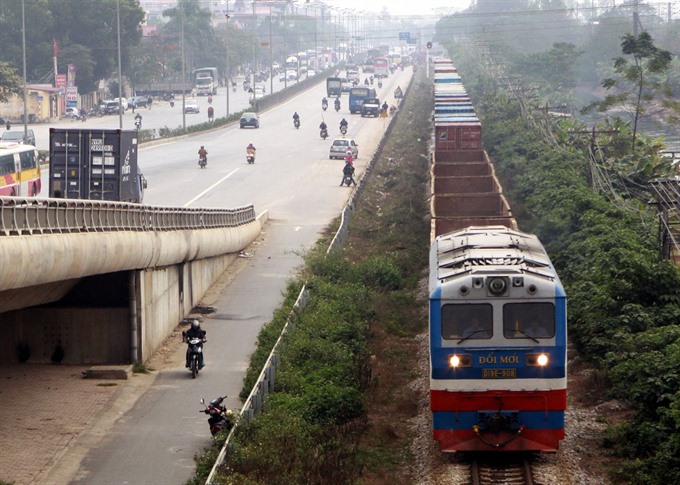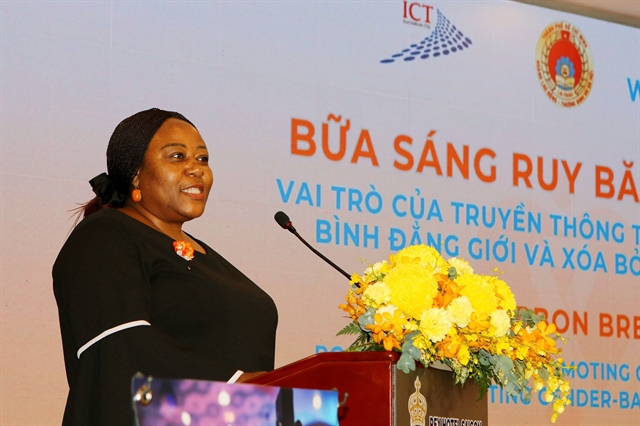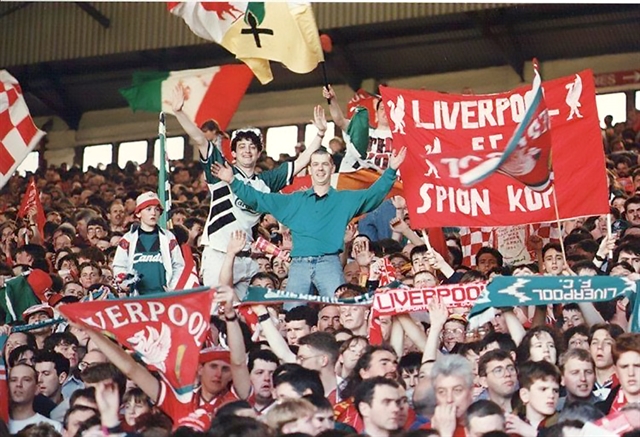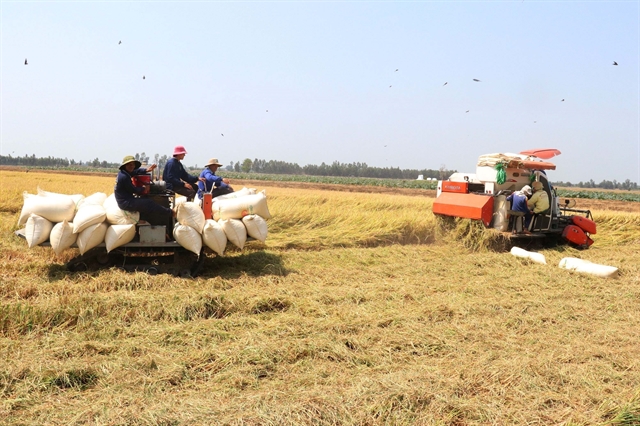 Society
Society

The railway sector in Việt Nam has lost the dominant position it enjoyed two decades ago, and is trailing far behind other modes of transport.
 |
| A freight train that can carry the equivalent of 20 container trucks runs on the Hà Nội-Hải Phòng route. — VNA/VNS Photo Thế Duyệt |
Đinh Tịnh
HÀ NỘI — The railway sector in Việt Nam has lost the dominant position it enjoyed two decades ago, and is trailing far behind other modes of transport.
The sector currently accounts for just four per cent of transport market, and enjoys a meagre 3.18 per cent allocation from the State Budget for its development.
Its stagnation is starkly evident in the outdated 1m-wide tracks that most routes in the country use, unchanged from when they were first laid during the French colonial period over a century ago.
The North-South railway, which connects the capital city of Hà Nội in the north with the biggest city in the south, HCM City, “has not seen a single new metre of railway track in nearly a hundred years,” said Lã Ngọc Khuê, former deputy transport minister.
The current Minister of Transport, Trương Quang Nghĩa, once told the media that his dream of a high-speed train railway “would not see reality in my term.”
The 500km route, once considered the strength of railway sector, is now facing stiff competition and dragged down by infrastructure deficiencies.
The Hà Nội – Lào Cai route, once a cash cow, has been struggling to attract passengers for around three years now.
Phùng Thị Lý Hà, Deputy Director of Hà Nội Railway Transport Co., said the company had reduced ticket prices, deployed more flexible run time and offered several promotion programmes, but these had not been very effective.
“From Hà Nội to Lào Cai Province, it takes 5 hours by road; on the train, it takes 8 hours,” Hà said.
The aviation sector makes the best railway route pale in comparison. The North-South train journey takes up to 30 hours and costs VNĐ 2 million ($88.1) . People can now hop on a plane for lower prices if they book their ticket early, and the journey time is less than two hours.
It gets worse
Unfortunately, the railway sector’s freight division, which should do well because of its highly competitive pricing, does not fare much better than the passenger division.
The central city of Đà Nẵng actually wanted the entire railway system removed, but the Ministry of Transport (MOT) has rejected the request.
The limited budget allocated for railway development, as mentioned earlier, also reflects the low priority accorded to the sector by the State.
According to the transport development master plan (from now until 2020 with a vision towards 2030), 700km of highways are expected to be completed by 2020 and another 2,200km by 2025. Within the same time frame, the Long Thành international airport in the southern province of Đồng Nai will also be built and national carriers will double their fleet to 300 aircraft.
Against this, the railway sector’s ambitious North-South project will only be ‘discussed’ after 2020. Even if it is approved and work commences right away, the project can only become operational by 2030 at the earliest, and will be a decade behind the road and aviation sectors.
Lukewarm interest
The State-run railway sector has been rolling out the red carpet for the private sector for several years now, but has not received an enthusiastic response.
In 2014, the MoT called for private investment in 16 projects, 12 concerning the existing railway system and the remaining four for building new railway routes.
When the list of 16 projects was made public, many big players including South Korea’s Lotte and domestic conglomerate SunGroup had expressed interest.
However, three years on, only one railway logistics project in Phú Yên Province has begun operations, the others are still in the consideration phase.
Vũ Tá Tùng, director of the State-owned Việt Nam Railways Corp (VNR), admitted that private capital would “naturally flow only into profitable areas.”
Tùng suggested an approach many other countries have used – allowing private investors to build stations into multiple-use complexes, complete with a bus system, underground metro, shopping malls, food stalls and entertainment services.
Similarly, in the railway freight division, the private sector could invest in infrastructure components like cargo yards and warehouses that would provide logistics services like loading, unloading and other support services, he said.
Khương Thế Duy, deputy head of the Việt Nam Railway Authority under the MOT, said that the ministry was planning to deploy the BOOT model (Build-Own-Operate-Transfer), piloting it on the Đà Lạt – Trại Mát route.
Under this model, private investors will use their own resources to upgrade or build new components for stations suiting their business activities, and after they have recovered their investment, the infrastructure will be transferred to the State. Alternatively, the investor can continue to lease the facilities.
“We hope the government will agree to this approach, because it can attract investors into other railway infrastructure projects, especially new rail routes that connect seaports and airports,” Duy said.
Medium-term surge
The Ministry of Transport has requested the Government to allot VNĐ7 trillion (US$308.6 million) from the State Budget for medium-term investment into the flagging railway sector.
Charged with the task of revitalising the sector, VNR said the majority of this money will be used for a “comprehensive upgrade” of the North-South railway infrastructure, the Thời Báo Kinh Tế Việt Nam (VnEconomy) reported.
There are 1,452 bridges on the North-South line, but nearly half of them, or 697, have fallen into a state of disrepair. The stations on the line are also not distributed properly, and 1,047 level crossings and 3,000 pedestrian crossings will need to be upgraded, according to Đoàn Duy Hoạch, deputy director of VNR.
The VNĐ7 trillion will go into four projects: upgrading the Hà Nội-Vinh route at an estimated costs of VNĐ1.6 trillion ($70.5 million); the Nha Trang – Sài Gòn route (VNĐ1.8 trillion, or $79.3 million); repairing bridges ($79.3 million); upgrading infrastructure and building three new stations on the Vinh-Nha Trang route ($79.3 million).
The sector is also working with banks and other credit institutions to borrow another VNĐ5 trillion ($88.2 million) over the next three years. This year, VNR expects to borrow VNĐ 2 trillion, which will go into manufacturing five new trains this year, and another 7-10 in 2018, each costing an estimated VNĐ100-120 billion ($4.4-5.3 million).
The railway sector’s goal now is not to focus too much of its resources on competing with other modes of transport like airways or road transport in terms of speed, but “on offering diverse and satisfactory services, flexible pricing schemes and a reasonable running schedule,” Hoạch said.
The newly made trains are expected to feature a VIP section (1-2 carriages) with more “luxury” furniture that will have higher ticket prices. Trains made in Nha Trang will be painted blue and white, predominantly, to “present a sense of freshness and friendliness.” — VNS









